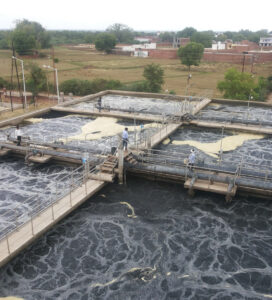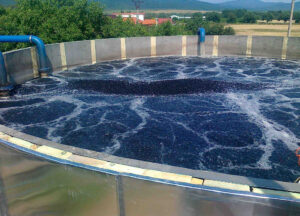Aqwise—Wise Water Technologies Ltd. is a global company, based in Israel, that specializes in moving bed bioreactor (MBBR) technology, a wastewater treatment technology that holds strong advantages over competing technologies in certain applications. In addition to creating its own carriers—small, ingeniously designed plastic cylinders with nooks and crannies that provide large amounts of surface area for bacteria and biomass to attach to during the wastewater treatment process—Aqwise has the expertise to help design and operate plants that use these carriers in the best way possible. The company has offices in Europe, Asia, and the Americas and has delivered projects in 55 countries worldwide.
In this interview, Marc Krieger, Aqwise’s vice president of sales, tells Municipal Water Leader about Aqwise’s technology and the advantages it can bring to appropriate applications.
Municipal Water Leader: Please tell us about your background and how you came to be in your current position.
Marc Krieger: I have a background in geology and earth sciences and have a master’s degree in what today is called environmental engineering, then called sanitary engineering, from the University of California, Berkeley. I’ve been in this field for over 30 years. I’ve worked for private consultants and for an Israel-based company that specialized in membrane-technology water treatment systems, and I’ve been with Aqwise now for 8½ years. While my background is in engineering, today I do sales.
Municipal Water Leader: Please tell us about Aqwise as a company.
Marc Krieger: Aqwise is a global company with its headquarters in Israel. We’ve been around for 20½ years. We started as a small startup company in the field of wastewater treatment, developing MBBR technology, a specific kind of biological treatment technology for municipal and industrial wastewater. Over the years, we’ve expanded from being a specialist in MBBR technology and all its diverse applications to developing and implementing anaerobic wastewater treatment solutions utilizing carriers. We’ve also moved into the project-execution field. Today, Aqwise has a full range of expertise both as a technology provider and as a turnkey contractor for executing wastewater projects. We have offices in Germany, India, Italy, Mexico, the Netherlands, Spain, and the United Kingdom and have partners spread around the world whom we support from afar. The company has about 80 employees worldwide.

Municipal Water Leader: How does Aqwise’s technology differ from other wastewater technology that people may be familiar with?
Marc Krieger: Aqwise’s in-house technology is MBBR. The world of aerobic biological treatment is divided between what are known as suspended growth technologies, the most common types being activated sludge and sequence batch reactors, and attached growth technologies, including trickling filters and MBBR. MBBR uses biomass carriers that are characterized by a high surface-area-to-volume ratio. They provide large surface areas on which bacteria and biomass can attach and grow in order to clean up the wastewater. MBBR technology has many advantages: It allows for smaller reactors and a treatment plant with a smaller footprint; it is also more efficient, more robust processwise, and better at sustaining hydraulic and toxic shocks in the waste stream. If you are treating wastewater that varies in its flow or quality, fixed-film technologies, MBBR in particular, are more adaptable and more suitable to treat it. MBBR also performs better for nitrification, especially in cold-weather conditions. This is another common application in the municipal field. Because MBBR requires a smaller footprint, it is possible to upgrade or retrofit existing reactors from activated sludge to MBBR and achieve an increase in capacity within an existing volume without additional civil works.
Municipal Water Leader: Is Aqwise’s innovation primarily in the design of the carriers?
Marc Krieger: MBBR technology has been around for about 35 years and was initially developed in Scandinavia because of its suitability for cold-weather conditions. Aqwise’s contribution has been to develop its own carrier with a characteristic geometry, size, and shape. Even more importantly, we have developed proprietary design tools that are suitable for our carriers. Designing an MBBR installation is not just about putting plastic carriers into a tank. You have to know what size tank to use, how to stage it, and what quantity of carriers is required to get the job done. Our expertise goes beyond developing our own carrier and involves building the design tools and the knowledge to use these carriers in a way that will achieve the best results for our clients. There are other companies that manufacture carriers but don’t have the design tools to support a client in designing a plant so that the MBBR process functions in an optimal manner. This is our main advantage: We provide the complete design package to the client so that the plant will perform properly. Over the 20 years that we’ve been in business, we’ve provided our technology for close to 600 applications in over 55 countries worldwide. Our main strength lies in our experience and our knowledge of how best to use the carriers.
Municipal Water Leader: How big are the individual carriers?
Marc Krieger: The main parameter of concern in designing an MBBR is what we call effective surface area: how much surface area is available for biomass to grow on within a certain volume of carriers. The numbers in the market range between 300 and 1200 square meters per cubic meter. Aqwise carriers range from 650 to 800, which is considered on the high side. That means that with a relatively small amount of carriers, you have a high surface area and can achieve high treatment efficiency. Physically, the carriers are small cylinders, about 13 millimeters (mm) long and 13 mm in diameter. They are quite small, but they have lots of internal areas on which the biomass can grow. That is more important than their physical size.
Municipal Water Leader: Please tell us about your downflow anaerobic carrier system (DACS).
Marc Krieger: The DACS is an anaerobic wastewater treatment technology that uses carriers to create a blanket of anaerobic sludge. Anaerobic treatment is used primarily in high-strength industrial wastewater treatment; it is not prevalent in the municipal sector. For food industries, beer breweries, pulp and paper factories, and bottling plants with high loads of organic material and high levels of chemical oxygen demand, there is an advantage to using anaerobic technology because it can generate biogas which can then be used to generate steam, hot water, or electricity.
DACS technology has certain advantages over conventional anaerobic technologies on the market. Its most common competitors are the upflow anaerobic sludge blanket (UASB) technology and the internal circulation reactor. Since in the DACS the biomass is attached to a blanket of carriers, there is no risk of losing your biomass or having it washed out of the anaerobic reactor, as there is with other technologies. DACS technology emerged from a joint venture between a Dutch group with previous experience in anaerobic technology and Aqwise, which eventually led to the creation of the Netherlands-based company Aqana. Aqana is a subsidiary of Aqwise and manages the anaerobic side of the business. We work together in our sales efforts and project execution.
Municipal Water Leader: What results have your clients seen from your technology?
Marc Krieger: The results are more or less dictated by what the client wants. Our clients will come to us and define their needs: They’ll tell us their flow, their inlet quality, and what they want to achieve. One main advantage of MBBR is that MBBR reactors are 30–40 percent smaller in volume in comparison with activated sludge reactors designed for the same parameters. For clients that have space limitations or that are dealing with high real estate values, saving land saves money. The other main advantage is the ability to retrofit existing plants from activated sludge to MBBR in order to increase capacity. This is a simple, low-cost way to expand the capacity of a treatment plant that does not require additional land or civil works. Other advantages that our technology provides are the ability to convert treatment plants that have been designed for secondary treatment only—meaning achieving biochemical oxygen demand and total suspended solids reduction—to also achieve biological nutrient removal (BNR) and low levels of total nitrogen. That is important now because of the current focus on nitrogen levels in the environment. Plants can be converted from activated sludge to what we call integrated fixed-film activated sludge, which is an integration of activated sludge and carriers that delivers low nitrogen values in the effluent. These are types of projects in which our technology can provide simple and relatively low-cost solutions to achieve what the client defines.

Municipal Water Leader: How expensive is it to retrofit an existing plant?
Marc Krieger: A retrofit has many components: civil works, piping works, and the purchase of the carriers. Costs will vary from site to site and from project to project, but the advantage of retrofitting an existing plant over the alternative of building a new one is obvious: You minimize your need for additional land and additional civil works. One of the challenges of retrofits is upgrading an existing plant while it’s still in operation. You can’t just close down a treatment plant in order to do an upgrade. It has to be done in such a way that the plant can continue to function during the retrofit.
Municipal Water Leader: How do you find new clients?
Marc Krieger: What’s important for us is to identify and find those specific applications and specific clients to whom MBBR technology would bring the most benefit. We’re not looking to introduce MBBR to every treatment plant out there, but just to find those for which MBBR has significant advantages over other technologies. One of our special focuses is industries that are looking to expand their wastewater treatment plants and can use MBBR to do so with minimal space requirements. Another focus is municipalities that are looking to expand their plants or upgrade them to achieve BNR. This is happening the United States, but also in India, the Philippines, and countries in Southeast Asia. These are major markets for us.
There are also other niche markets in which MBBR is common. One of them is the aquaculture business. If you’re growing seafood or fish in ponds, MBBR is the technology of choice to achieve nitrification of the water so that it can be reused or recycled through fishponds. We also use MBBR for denitrification applications, for example, to denitrify groundwater in regions that suffer from high nitrate levels in their groundwater, including parts of California, Israel, and Italy.
Our workload is divided equally between industrial and municipal projects. Industrial projects tend to be smaller in terms of capacity but are more challenging with regard to quality issues. Municipal projects are larger in size but are quite standard in the water quality they aim to deliver. While our work is split 50/50 between industrial and municipal projects, our engineer-procure-construct work focuses mostly on industrial projects.
Marc Krieger is the vice president of sales at Aqwise. He can be contacted at marc@aqwise.com. For more information about Aqwise, visit www.aqwise.com.
